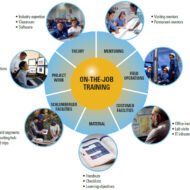Posted by Managementguru in Business Management, Human Resource, Principles of Management, Training & Development
on Mar 22nd, 2014 | 0 comments

Popular Recruitment Channels Personnel procurement involves recruitment, selection and placement of capable employees who act as the key players in determining the success or failure of an organization. Recruitment serves the purpose of identifying and luring prospective candidates for the actual or anticipated vacancies of the organization. Recruitment is termed “positive” in that it stimulates employees to apply for jobs in organizations to increase the “hiring ratio”, that is the number of applicants for a job. Personnel Inventory: Recruitment is an extensive process that has to be dealt with care by companies as it is the first step for preparing personnel inventory that matches the criteria laid down in job specification and to select only those who are found suitable for the vacant positions. Selecting right people for the right job is very important as it ensures organizational stability and consistency. The sources of recruitment can be internal or external. Internal sources of recruitment comes in handy when you want people to understand and respond well to overall objectives of the organization which can be achieved by promotions, quite suitable for managers at the middle level and top level. Those already working for the organization will be quite familiar with the activities and requirements of the firm and a promotion would serve to boost their morale, thus resulting in improved performance coupled with commitment. External sources of recruitment may be as follows: Advertising: This method is suitable when the organization plans to expand its activities across the geographical boundaries and attract talent which is spread out. The company to reach out to a larger target group can advertise its requirements through print media, radio, television, professional and technical journals. This is a popular way of recruitment as the response ratio is quite on the higher side when compared to any other source of recruitment. Employment exchanges: The unemployed personnel register their names and qualifications in the exchanges and special employment exchange sources are organized for ex-military personnel, physically handicapped and professionals in different places. It is really a matter of concern that a major percentage of youth prefer only white collar jobs and they rate other blue collar jobs and self employment opportunities a step lower. This attitude should change as there will be no permanent jobs existing in the future but only projects. Eventually people will be shifting between various projects and at the end of the day, whether they derive any satisfaction or a feeling of cherishment about their job or work will become a big question mark. Schools and colleges: These are excellent sources of external recruitment as corporate companies offer good placement opportunities to students studying in business schools and other engineering and professional institutions even before the completion of their degree and students should aim to acquire admission in reputed educational institutions as it increases the chance of confirmed placement. Popular software and engineering companies want the best talent in the industry and the benefit of hiring freshers is that they can be well trained and molded as per their job requirements. Trade unions: In firms where trade unions are effective, the management looks up to the union in their recruitment efforts. It makes possible good labor relations. Advantages of recruiting from outside the company: Employees from varied background with broad experience add value to the company The new employees can infuse fresh ideas that may prove fruitful. Strategic Principles of recruitment: Employ the best qualified person for each job Retain the most promising ones Offer promising careers and security Provide opportunity for empowerment Be competitive with public policies Provide facilities for personal growth on skill and knowledge. Other Sources: Other sources...

Posted by Managementguru in Human Resource, Principles of Management, Project Management, Training & Development
on Mar 22nd, 2014 | 0 comments

On The Job Training Methods For Effective Employee Development The method by which training is delivered often varies based on the needs of the company, the trainee, and on the task being performed. The method should suit the audience, the content, the business environment, and the learning objective. Ideally, the method chosen will motivate employees to learn, help employees prepare themselves for learning, enable the trainees to apply and practice what they’ve been taught, help trainees retain and transfer what they have learned, and integrate performance with other skills and knowledge. The basic objective of training is learning which brings about a radical change in the perspective of an individual preparing him for the task. On the Job Training: This is the most common method of training. The trainee is placed on the job and the manager or mentor demonstrates the trainee how to do the job. To be successful, the training should be done according to a structured programme that uses task lists, job breakdowns, and performance standards as a lesson plan. Common on the Job training methods include:- Demonstration: Demonstration is very effective for basic skills training. The trainer shows trainees how to do something. The trainer may provide an opportunity for trainees to perform the task being demonstrated. Panel: A panel provides several points of view on a topic to look for alternatives to a situation. Panel members may have differing views but they must also have objective concerns for the purpose of the training. This is an excellent method for using outside experts. Projects: Projects require the trainees to do something on the job, which improves the business as well as helps them learn about the topic of training. It might involve participation on a team, the creation of a database, or the forming of a new process. Employees can voluntarily under-take some small projects that would better the performance of a system. This would help the employee to become noticed and others ease of doing a particular thing and a source of inspiration. Say, Simplifying a database application by introducing a new software. Mentoring: A mentor can tutor others in their learning. Mentors help employees solve problems both through training them in skills and through modeling effective attitudes and behaviors. This system is sometimes known as a buddy system. Visit our GUMROAD Ebook Store for all your MBA guide...




